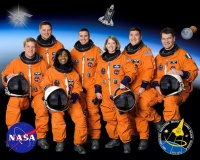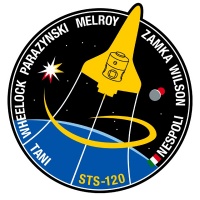STS-120
From The Space Library
 | |
| Organization | NASA-Office of Space Flight (United States) |
|---|---|
| Mission type | Resupply/Refurbishment/Repair |
| Launch date | October 23, 2007 |
| Launch vehicle | Space Shuttle |
| Launch site | Cape Canaveral, United States |
| COSPAR ID | 2007-050A |
| Inclination | 51.6 degrees |
| Experiments | Here |
| Alternate Names | 32272 |
| Additional Information | Here |
| Data Collection | Here |
| Payload Mass Up | 15337.31 kg |
| Payload Mass Down | 918.18 kg |
| Orbiter | Atlantis |
| Lift Off Mass | 2,056,412.27 kg |
| Orbiter Weight at Liftoff | 121,898.64 kg |
| Orbiter Weight at Landing | 91,880.91 kg |
| Landed | 1:01 p.m. EST, concrete runway 33, Kennedy Space Center, Fla. |
| Orbits of Earth | 238 |
| Orbital Altitude | Approximately 210 nautical miles |
Contents |
[edit] Crew
- Commander: Pamela A. Melroy
- Pilot: George D. Zamka
- Payload Commander:
- Mission Specialist 1: Scott E. Parazynski
- Mission Specialist 2: Douglas H. Wheelock
- Mission Specialist 3: Stephanie D. Wilson
- Mission Specialist 4: Paolo A. Nespoli, European Space Agency (ESA)
- Mission Specialist 5:
- Payload Specialist 1:
- Payload Specialist 2:
ISS/Mir Crew Transport
- Daniel M. Tani - up only Clayton C. Anderson - down only
[edit] Mission
STS 120 is an American shuttle satellite that was launched from Cape Canaveral at 15:38 UT on 23 October 2007, on its way to the International Space Station (ISS). It carried seven astronauts (six Americans and an Italian) and several tonnes of material to the station. It docked with the ISS on 25 October. In the first spacewalk on 26 October, two astronauts moved and installed an Italian-built, 4.4 m diameter, 7.2 m long, 14.3 tonne aluminum tubular module named Harmony to facilitate connecting, in future, the European Columbus laboratory in December 07, and the Japanese Kibo laboratory in February and April of 2008. Harmony will be the passage corridor between the American Destiny labs and these future labs. On the second spacewalk, two astronauts moved a pre-installed massive truss to a different location. The truss work continued on the third spacewalk, when they noticed that there was a 90 cm long tear on the solar panel. Additionally, the rotary joint that aims another panel to the Sun was also discovered to be in need of repair/replacement. The fourth four-hour long spacewalk by a single astronaut on 3 November was confined to successfully repairing the torn solar panel with "cuff links", and ensuring full power availability. The rotary joint problem was deferred to until the next shuttle mission. The contemplated additional inspection of the shuttle tiles was also determined to be ignorable. The shuttle is scheduled to leave the station on 5 November 2007, returning to Earth by 7 November.
[edit] EVA
Extravehicular Activity (EVA) conducted by Scott Parazynski, Doug Wheelock, and Daniel Tani during four spacewalks for a total of 27 hours, 14 minutes. EVA 1, 6 hours, 14 minutes; Parazynski and Wheelock installed the Harmony module in a temporary location on the ISS and readied the P6 truss for its relocation. EVA 2, 6 hours, 33 minutes; Stephanie Wilson and Wheelock used Canadarm2 to grapple the P6 truss secured atop the Z1 truss. Parazynski and Tani teamed to disconnect cables from the P6, allowing it to be removed from the Z1 truss. Tani visually inspected the station's malfunctioning starboard Solar Alpha Rotary Joint (SARJ) and gathered samples of "shavings" he found under the joint's multilayer insulation covers for analysis. EVA 3, 7 hours, 8 minutes; Parazynski and Wheelock installed the P6 with its set of solar arrays at its permanent home. As the P6 solar arrays, which had been stowed during previous shuttle visits, were deployed, one experienced a tear in a blanket as it reached the 80% deployed point. EVA 4, 7 hours, 19 minutes; Parazynski, riding on the station's robot arm extended by the OBSS, cut snagged wires and installed array-stabilizing cuff links designed to strengthen the array's structures so it would not tear further. Parazynski took care to keep clear of the swaying array, occasionally dampening its motion with a prodder shaped like a hockey stick. Wheelock kept watch from the base of the solar array to ensure a safe distance was kept between Parazynski and the electrically charged solar array. After completion of the repairs, the crew was able to fully deploy the solar array.
[edit] Payload
ISS Assembly Flight 10A; Node 2 connecting module; crew exchange
[edit] Books about the Space Shuttle Program
Buy This Book Click here |
Buy This Book here |
Buy This Book Click here |
Buy This Book Click here |





